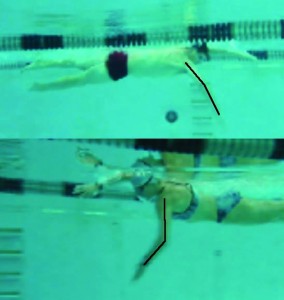Underwater Pull – The High Elbow
It doesn’t matter how long you’ve been swimming, working on improving your technique is never ending. One of the biggest problems that swimmers of all abilities run into is that they drop their elbow as they pull underwater. If you’ve been swimming for a while you’ve heard about this many times. If you’re relatively new to the pool, the concept of keeping a ‘high elbow’ during your pull isn’t always the easiest thing to get your head around. So let me try and help.
Let’s start at the point in your stroke I refer to as the ‘glide’. Your hand has just entered the water and extended out in front of you. The next step is to begin your pull, or in swimming slang, the catch. The pull begins with your hand pulling downward while your shoulder/upper arm remain right where there are. This creates a pivot point at your elbow and creates an ‘early vertical forearm’. There are a couple of reasons for this. First of all, by pulling with your elbow high and your forearm vertical, you’re using your hand AND forearm to pull through the water. Using both creates a much larger paddle to pull with than just your hand alone. Secondly, by keeping your elbow high throughout your pull, you are using your larger back muscles. If you swim with your elbow dropped, or leading the rest of your arm through the pull, you use smaller tricep muscles to pull. Finally, with your elbow leading, it creates a slipstream for your hand to follow, which makes it hard for you to get a strong pull.
Like I mentioned before, this is seen in all levels of swimming. Beginners tend to start this as a bad habit. Experienced swimmers start to drop their elbow as they fatigue because they are trying to keep up the same stroke rate.
Here’s an example of a good swimmer who drops her elbow as she pulls.
As you can see, it’s very subtle. Overall it’s a great stroke, but if you focus you attention on her pull, you can see that elbow down and her stroke slipping a little.
By contrast, take a look at the next video. You can see that the elbow is higher in the water and the pull is more effective.
Can’t see any difference? Let me put them side by side.

The swimmer at the top of the picture has a ‘high elbow’ (or early vertical forearm as some call it). If you look at the superimposed line I put over the arm you can see that the forearm and the hand are acting as one and leading the sweeping motion of the pull. Looking and the swimmer at the bottom of the picture, you can see that the elbow is dropped slightly and is leading the hand and forearm through the water. This doesn’t allow the hand and forearm to ‘grab’ the water, or get an effective pull.
So how do you prevent this from happening? First of all a deeper pull tends to help things. People who pull with their elbows bent at a high degree tend to be more prone to letting that elbow slip. Second, there are a few drills that you can do to work on it. Catch up freestyle (letting one arm do a complete swim stroke and “catch up” to the other arm before the other arm begins its stroke) will isolate each arm allowing you to make some focused adjustments. Using hand paddles can help as well. The paddles (be sure they’re sized right and not too small) will exaggerate your stroke and make it easier to find and adjust the problems. The bottom line though is that you need to pay attention to your stroke. If you have someone like a coach or training partner that can watch your swim, get their input as well.

Hi,
First thanks for your articles, they helped me to improve kicking for the core.
Now I am still struggling with my stroke, trying to connect it to my core muscles. I sense the point from your videos but your discussion doesn’t solve the problem.
Might it be that the anti-dropped-elbow trick is
bend the elbow slightly while lifting and rotating the upper arm at the shoulder
as written in the h2ouston post http://www.h2oustonswims.org/articles/dreaded_dropped_elbow.html?
Thanks again.